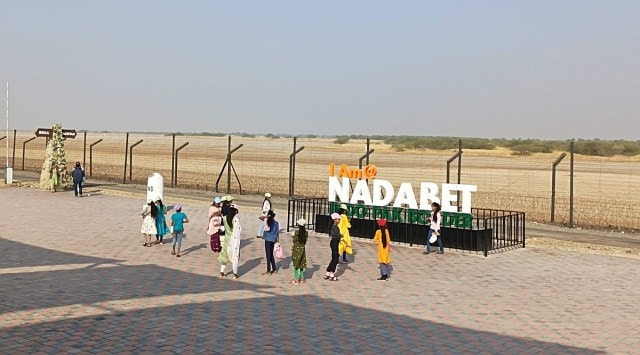Birds Without Borders: A day at Gujarat’s Nadabet on the Indo-Pak border
This island is also a host of the Seema Darshan project of the Gujarat government floated to promote border tourism on the lines of Wagah border since 2016.
 Nadabet is an island on the Indo-Pakistan international border in the vast Great Rann of Kutch (GRK). (Express photo by Gopal B Kateshiya)
Nadabet is an island on the Indo-Pakistan international border in the vast Great Rann of Kutch (GRK). (Express photo by Gopal B Kateshiya) The turquoise waters of Vaniyasar, a historic pond, easily catches one’s eye in the arid landscape of Suigam, the village on the Indo-Pak border, which is the headquarters of the Suigam taluka of Banaskantha district on way to Nadabet.
This island is also a host of the Seema Darshan project of the Gujarat government floated to promote border tourism on the lines of Wagah border since 2016. The village is some 50 km from Pakistan, as the crow flies.
 Barbed-wire fencing at Indo-Pak border dividing the desert at Nadabet. (Express photo/Gopal B Kateshiya)
Barbed-wire fencing at Indo-Pak border dividing the desert at Nadabet. (Express photo/Gopal B Kateshiya)
If one pulls over on the bridge of National Highway 68, which bisects this pond, one is likely to be greeted by the sight of flocks of migratory birds, including Eurasian wigeons, common teals, tufted pochards, common pochards, pintails, gadwalls, northern shovelers and other dabbling ducks.
Local birds like the great crested grebes, little grebes, purple moorhens, Eurasian coots, cormorants and herons can also be found keeping their colourful international guests company in this small pond.
Located at the trijunction of Banaskantha, Patan and Kutch districts in northern part of Gujarat, Suigam is the last point for tourists to tank up before heading to Nadabet, the island on the Indo-Pakistan international border in the vast Great Rann of Kutch (GRK). While the tourists may like to cruise on the largely traffic-free road leading to Nadabet, it is very likely that they will be distracted by large flocks of rosy and Dalmatian pelicans, the large migratory birds, hovering over Suigam lake near Hinglajmata temple on the outskirts of Suigam, as if suggesting geographical borders don’t matter.
If one cares to stop by and cast a glance at the waterbody, besides the pelicans, one would find hundreds of greater and lesser flamingos, gulls, egrets, ibises etc foraging there.
 Viewing deck way to Point Zero (Express photo/Gopal B Kateshiya)
Viewing deck way to Point Zero (Express photo/Gopal B Kateshiya)
But the milestones on the roadside urge tourists out for Seema Darshan to hurry up towards the desert past Jaloya, the last village on the border of the vast expanse of mudflats and saltflats dotted by sandy-soiled yet vegetation-covered islands like Nadabet, Jagmalbet, Narbet, Dhanbet, Boriyabet etc. As one leaves human settlements behind while racing towards the steely border, non-human species take over the landscape. Any white-coloured apparition visible on the horizon from the road in this area, unmistakably turns out to be a herd of Indian wild asses (equus hemionus khur) as one drives closer. The saline desert and shrublands of GRK, the Little Rann of Kutch (LRK) and parts of Rajasthan are the only home in the world for the mostly playful Indian wild asses.
But no, they are not the only inhabitants of this farfetched area. Blue bulls (nilgai), Asia’s largest antelopes, remain invisible from distance thanks to the bluish-gray coats of the males and reddish-brown of the females. But they seem to be constant companions of the wild asses in this area, even in raiding agricultural fields at night, farmers in villages complain.
One finds herds of the two species having their sunbath in the mudflats along the road to Nadabet on cold winter mornings. They seem aloof from each other though male wild asses often trot around, as if challenging the bulky blue bull males for a 100-metre race. They also seem aloof from the fuss over the border of India and Pakistan. So much so that herds of these two large mammal species are a fairly common site near the Seema Darshan reception at Nadabet, 10 km inside the desert, knowing little that the two neighbours have fought four wars, including the 1971 war in which this section of the border had witnessed action and that the Indian forces had advanced towards Pakistan and captured a few hundred square kilometre (sq km) of Pakistani territory only to return it after the two countries signed the Shimla Agreement in 1972.
 Imperial Eagle. (Photo by Uday Vora)
Imperial Eagle. (Photo by Uday Vora)
However, some other species have understood the importance of this border rather the hard way, say experts. “I have seen Asian houbara hunting parties making merry on the Pakistani side of the border. They would shoot houbaras dead at will,” says Uday Vora, a retired Indian Forest Service officer who has served in the Wild Ass Sanctuary (WAS) spread across the LRK and this northern tip of the GRK.
Houbaras migrate to India and western Pakistan from their breeding grounds in central Asia and the Middle East during winters. A staff member at Seema Darshan reception says that houbaras are sighted near Nadabet although this species of the bustard family is more common in LRK and Kutch where they find safe sanctuaries on the Indian side of the border.
While the submerged stretches and marshlands surrounding Nadabet pose a formidable challenge to the Border Security Force (BSF) in patrolling the border, the same wetland attracts lakhs of birds, both international migrants and locals. Mornings at the Seema Darshan in winter can be musical with melodic metallic calls of migratory common cranes coming from a distance and chattering of the resident desert wheatears from the parking lot.
 A view of Salt desert and mudflats (Express photo/Gopal B Kateshiya)
A view of Salt desert and mudflats (Express photo/Gopal B Kateshiya)
Flocks of pelicans flying from one part of the wetland to the other don’t feel threatened by imperial eagles and kestrels perching majestically on the top of electricity poles along the 25-km road from the Seema Darshan reception to the Zero Point on the Indo-Pak border. If one climbs the viewing deck along this road, one finds waders like the little stint, common snipe, common greenshank, ruffs, green sandpiper, marsh sandpiper, pied avocets, black-winged stilts and scores of other species scintillate like stars in the dull mud-land, their numbers intimidating for any birder to attempt to estimate.
Similarly, by virtue of their sheer numbers, lesser and greater flamingos create a pinkish haze on the water surface during the morning hours. On the roadside, migratory black storks, which are considered rather rare in Gujarat, happily forage with their Gujatati hosts painted storks.
A census of waterbirds, conducted by wildlife biologist Bharat Jethva, Vora and others in 2016, had estimated that there were 6.58 lakh birds of 60 species in this wetland spread over around 1,000 sq km. They included three lakh greater flamingos, two lakh lesser flamingos, 25,500 rosy pelicans, 1,475 Dalmatian pelicans (among the world’s heaviest birds with flight), 21,000 spoonbills, 10,000 common cranes etc in this seasonal wetland.
This part of the GRK is flooded by the floodwaters of the Luni river during the rainy season. The water lasts till the onset of summer, providing an important resting and feeding ground to birds migrating along the Central Asian Flyway (CAF) for wintering in the Indian subcontinent, birdwatchers say. For many migratory species, this is an important first stop after crossing the vast Thar desert during their migration from Central Asia, Russia, Europe etc to India and the last staging ground during their reverse migration. A young BSF jawan at the checkpoint on the road leading to the Zero Point is all smiles while pointing to a few red-vented bulbuls chirping in the thicket of toothbrush trees covering his and fellow jawans’ quarters there. “They have eaten up all the fruits. There is none left. But I thank these birds for keeping us company,” he says.
 Flamingos. (Photo by Uday Vora)
Flamingos. (Photo by Uday Vora)
As a tribute to the richness of this wetland, an Egyptian goose was sighted on January 7 this year, the first ever record of this species in entire India. A flock of 24 common shelducks, which are also considered rather rare in the state, was also sighted in this wetland on January 12. Besides birds, herbivores also thrive here. Besides wild assess and blue bulls, Indian gazelles (chinkaras) can also be sighted rather easily in this part of the desert. But the gazelles dart away in their typical jumping-sprinting style at the slightest disturbance caused by the presence of tourists. And well, where do they run away to? Narbet (literally meaning, island of wolves). Yes, while rare for tourists, forest officers say a pack of wolves also range this wetland besides the BSF jawans and forest guards.
Thanks to the diversity of birds it supports, the 566 sq km stretch of this wetland falling on the Pakistan side of the border was declared a wetland of international importance by the Ramsar Convention of the UN in 2002 after Pakistan recommended its listing.
“That Ramsar site, which is the largest in Pakistan, covers only around 30 per cent of this wetland. The rest 70 per cent falls in India. Given its location in the sensitive and farfetched area, Nadabet has not been explored much by the birders community so far. But the Seema Darshan project, which was launched by the Gujarat government in 2016, has opened access routes to this wetland. The tourism project has also put the area on the tourism map. If India also recommends this wetland for Ramsar listing, this transborder wetland will get attention it deserves in terms of conservation and protection,” Vora, who is now the honorary secretary of the Bird Conservation Society of Gujarat (BCSG), says, while warning, “This is a unique ecosystem. The apprehension is that renewable power developers will find large tracts of lands here very attractive.”
The retired IFS officer says Nadabet wetland supports one per cent of biogeographical populations of 11 bird species, including rosy and dalmatian pelicans, greater and lesser flamingos, painted storks, Eurasian spoonbills, slender-billed gulls, black-headed gulls, brown-headed gulls, pied avocets and common cranes and meets many other criteria to qualify as a wetland of international importance under the Ramsar Convention.
 Eurasian spoonbills. (Photo by Uday Vora)
Eurasian spoonbills. (Photo by Uday Vora)
B Suchindra, chief conservator of forests (CCF) of Gandhinagar wildlife circle, in whose jurisdiction this area falls, agrees, the wetland is very rich. “Not just for waterbirds, this part of the desert is as good as the LRK for raptors and houbara bustards too. However, unlike Nal Sarovar and Thol wetlands, we lack systematic data about species diversity and population abundance of birds at Nadabet to recommend this wetland for Ramsar listing,” the CCF says, adding there is no proposal as of now to recommend this wetland as a Ramsar site.
Nal Sarovar Bird Sanctuary and Thol Wildlife Sanctuary near Ahmedabad, Khijadiya Bird Sanctuary near Jamnagar and Wadhwana dam near Vadodara are the four Ramsar sites of Gujarat. “The boundary that we see here is a political boundary. Cultures are boundary-less and so are birds,” Siddharth Vaishnav, a veterinarian from Vadodara who had come with his parents at ‘Zero Point’ says while pointing towards the border pillar No 960 beyond the barbed-wire fence at the border.












